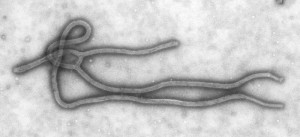
Ebola Virus Outbreak in Guinea
Medical students spend hours upon hours in the classroom learning about the transmission, diagnosis, treatment, and prevention of infectious diseases on a daily basis. While it is important to learn as much as possible from professors and textbooks in order to be successful doctors, it is equally imperative for medical students to stay informed about current events, especially those that are medically related. Of note, there is currently a dangerous outbreak of Ebola virus in the country of Guinea in West Africa that has led to over 100 infections and already 83 deaths in the past month alone. In fact, there have been multiple reports of the virus spreading to the densely populated capital city of Conakry, which is troubling due to the fact that it has historically only been seen in rural parts of the world. In light of this deadly disease, here are a few points of information about Ebola virus that are important to know:
What is Ebola?
Ebola is a virus that belongs to the Filoviridae family of enveloped and single-stranded, negative-sense RNA viruses. Since 1976 when Ebola was first reported in the country formerly known as Zaire, there have been 5 documented species of Ebola virus known to cause infection. Each one is classified by the country or region in which they were found to have caused an outbreak of disease, which include Sudan, Uganda, Cote d’Ivoire, and even Virginia, where lab primates imported from the Philippines were found to have been infected.
What are the signs and symptoms of Ebola Virus Disease?
Upon entry into a human host, the virus causes damage to the blood vessels of the body leading to an array of different symptoms. The incubation period usually lasts between 2-21 days. Initially, the clinical presentation involves intense weakness, fever, muscle pain, and other influenza-like symptoms. As the virus damages the circulatory system and elicits inflammatory responses by the human immune system, more severe issues such as hypovolemic shock and hemorrhagic fever develop. Of note, this viral disease has a 90% fatality rate.

How is it spread?
Although there is still controversy over the natural reservoir of Ebola virus, it has been well documented that fruit bats (Hypsignathus monstrosus, Epomops franqueti and Myonycteris torquata) are the most likely candidates. In many rural parts of Central and Western Africa, fruit bats are considered a delicacy leading to the initial infection in humans. In addition, the handling of other exotic animals such as non-human primates and rodents that have been infected, has been reported to further spread of the disease. Once a human is infected, the virus can be transmitted from person to person through direct contact of blood, mucous membranes, or bodily fluids.
How is it treated/prevented?
There is currently no vaccine or antiviral agent to prevent or treat Ebola virus disease. If an outbreak is suspected, quarantining is vital to limiting the spread of infection. In addition, raising awareness of the potential threat of infection to those who are risk is also an important task, which includes educating people in rural areas to avoid consumption and handling of exotic animal meat.
Is there ongoing research to come up with a vaccine?
Many pharmaceutical companies and academic laboratories are currently working on creating both effective vaccines and treatments against Ebola virus. In fact, an article recently published in the International Business Times reports that a Canadian pharmaceutical company called Tekmira Pharmaceuticals Corp3. has begun clinical trials for a drug called TKM-EBOLA to treat Ebola viral infections. According to the article, “in January the company dosed the first human subject in a clinical trial” and in March received a “fast-track designation” from the Food and Drug Administration to expedite the trial process.
Sources
1) http://www.nytimes.com/2014/04/02/world/africa/ebola-reaches-guinean-capital-stirring-fears.html?hpw&rref=health&_r=0
2) http://www.who.int/mediacentre/factsheets/fs103/en/
3) http://www.ibtimes.com/us-defense-department-spent-140m-ebola-treatment-research-theyre-getting-close-1566666


